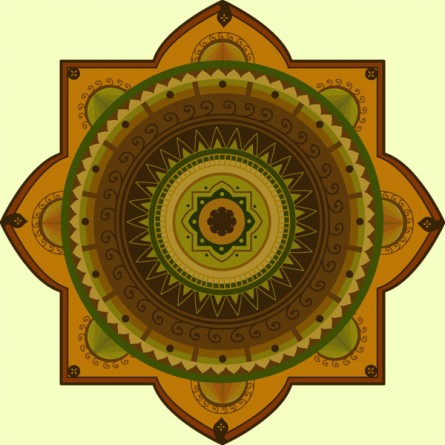Burial Instructions
Selecting the Location:
The consensus of the group determines where the vases are to go. Trusting our intuition, a clear knowing always emerges. In the beginning, we responded spontaneously to requests and went where we were led. How could we possibly decide where the vases should go when the need was so great? Now, after twenty years of contemplating the dire need for healing and protection for the Earth, certain places have insisted that we go there. We want to embrace the whole Earth with the practice and make sure we are effectively reaching out around the entire globe. Each location is like an acupuncture point on the body of the Earth and each vase is like a needle bringing balance and healing, connecting all the points around the Earth like the meridians flowing with energy throughout the body.
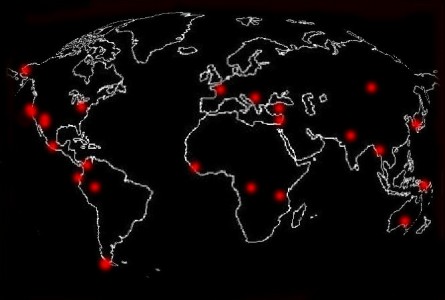
Earth Treasure Vase locations- or energy hot spots- around the globe

Hugh Wheir digging a hole for the Earth Treasure Vase at the mouth of the Rio Grande
Traditionally, an Earth Treasure Vase would be placed in areas where the elements are strong such as near the source of mighty rivers, on mountaintops, or at the base of ancient trees.
We feel it is important that the vase not be buried on private land but rather, in an area that is accessible to the public so that the vase is not only helping one but all. In certain cases, private land may, however, be the only option.
Sealing the Vase:
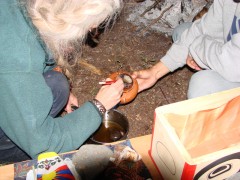
Sealing the Earth Treasure Vase with wax before it is buried in Arctic Alaska
When the vase is full and ready to be buried, the cork is put in for the last time and sealed permanently with melted beeswax. The five colored silks are draped over the cork, one by one after it has dried.
The five colors of silk relate to the Mandala of the Five Buddha Families in the Tibetan Buddhist tradition. These teachings deal with the basic elemental energies of life and the transformation of habitual reactive patterns into primordial wisdom.
White represents the center, the element space, and the wisdom of All-Encompassing Spaciousness.
Blue represents the east, the element water, and Mirror-like Wisdom.
Yellow represents the south, the element earth and the Wisdom of Equanimity.
Red is the west, the element fire, and the Wisdom of Discriminating Awareness.
Green is the north, the element air, and the Wisdom of All-Accomplishing Activity.
Together, they form a mandala, or symbol of wholeness. Many cultures have similar depictions of the nature of wholeness, with different colors for the different directions. We have used these five colors to honor the Tibetan Buddhist tradition that the vases come from. As the silks are placed over the vase we hold the intention that with each color, our prayers go out in each of the directions represented.

Tying up the silks on an Earth Treasure Vase
After the silks have been put on the vase, they are secured with the ties, also of the five colors. A tight knot or bow is tied (to express our dedication and determination) around the vase. The ends are held together on top of the silks, pressed down and sealing wax is melted over the ribbons. With a seal in hand, pressing down on the hot wax, the ties are sealed firmly to the silk. This way the vase is sealed upon sealed…never to be opened.
The Container:
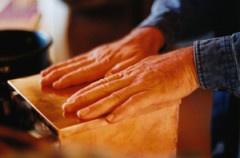
the copper box made by David Bacon
The vase is usually placed in a container to be buried. In each location it is something different but always strong and protective, traditionally of a solid wood covered with copper because copper conducts energy in the ground.

the Kosovo basket woven by Anne Wilson
In the beginning, many of our vases were buried in beautiful wooden boxes covered with copper crafted by Open Way Sangha member, David Bacon. When a vase went to Kosovo, an indigo-dyed hand-woven basket was made with copper wire threaded through it. In Alaska, Northwest Coast Indian artist, Joe David, painted a traditional cedar box with a frog totem especially for the occasion. The vase in
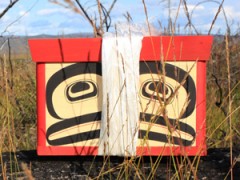
Alaska box with frog totem made by Joe David
Oakland was buried in a Cambodian rice carrier lined with copper mesh. The Biosphere 2 vase had a handmade wooden box covered in silver Milagros. When the vase was “buried” in the Pacific Ocean, it was placed in an underwater camera housing, safe inside of rubber gaskets, metal and glass.
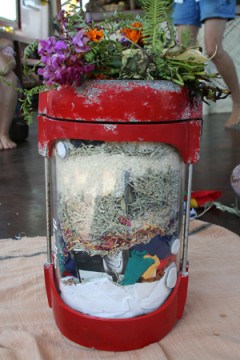
Papua New Guinea underwater camera housing
The vase is packed carefully so that it does not rattle around inside, and is well-padded. We have used dried flowers and herbs, fragrant leaves, rice and grains, etc., to pack the vase into its container. Then the container is closed and sealed as well.
Burying the Vase:
When it is time to bury the vase, the vase is first put in its container and then into a backpack or some satchel that is easy to carry. In the traditional way, we keep silence from the time we begin the journey to the time we bury it and are done — except for prayers or mantras silently invoked in order to stay focused on the task at hand.
Quite often we have only a general idea where the vase should go but it is not until we are on the road or on the path that the exact location is clear. In order to stay in a state of open mindedness and concentration, it is nice to do a walking meditation, coordinating the breath with the steps, and maintaining presence and full awareness.
When we arrive at the area, we may not already know the exact spot where the vase is to be buried and may need to look for it, opening up and allowing ourselves to be guided to the right place. Taking our time, watching for signs and trusting our intuition, we will find the perfect place.
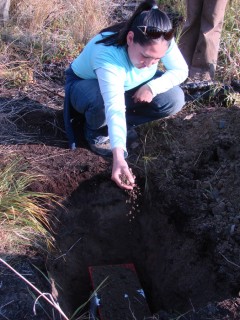
Cathy dropping earth into the hole for the Alaska Earth Treasure Vase. This vase was buried far out in the tundra, never to be disturbed
The vase should be placed in a hole that is deep enough to cover it very well. It should never be disturbed after it is buried, and no one need ever know it is there. Therefore the location is not marked in any way. Care must be taken that there are no unwanted influences or intruders that may disrupt things or later dig up the vase.
Before beginning to dig, we ask for permission of the local spirits in whatever way is appropriate, then dig the hole and place the Earth Treasure Vase in the ground. Filling in the hole with more prayers, songs, chants, and of course, Earth, we cover it completely, covering our tracks, and leave. The vase is now ready to do its job, and we have done ours.
There is really only one guiding principle in working with the Earth Treasure Vases: to maintain the intention to offer our truest aspiration for healing the planet and helping to restore the balance in nature for the benefit all life on Earth.
May all our prayers be fulfilled!
